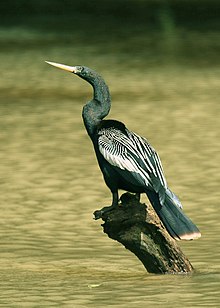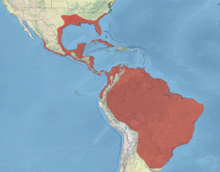Anhinga
From Wikipedia, the free encyclopedia
For the bird genus Anhinga, see Darter.
| Anhinga | |
|---|---|
 |
|
| Male in Costa Rica | |
| Scientific classification | |
| Kingdom: | Animalia |
| Phylum: | Chordata |
| Class: | Aves |
| Order: | Suliformes |
| Family: | Anhingidae |
| Genus: | Anhinga |
| Species: | A. anhinga |
| Binomial name | |
| Anhinga anhinga (Linnaeus, 1766) |
|
| Subspecies | |
|
A. a. anhinga A. a. leucogaster |
|
 |
|
| Range of A. anhinga Breeding range Resident range | |
| Synonyms | |
|
Plotus anhinga |
|
The anhinga (/ænˈhɪŋɡə/; Anhinga anhinga), sometimes called snakebird, darter, American darter, or water turkey, is a water bird of the warmer parts of the Americas. The word anhinga comes from the Brazilian Tupi language and means devil bird or snake bird. When swimming the origin of the name snakebird is apparent: only the colored neck appears above water so the bird looks like a snake ready to strike. They do not have external nares (nostrils) and breathe solely through their epiglottis.
The anhinga is placed in the darter family, Anhingidae, and is closely related to Indian (Anhinga melanogaster), African (A. rufa), and Australian (A. novaehollandiae) darters. Like other darters, the anhinga hunts by spearing fishes and other small prey using its sharp, slender beak.
Anhinga species are found all over the world in warm shallow waters. The American anhinga has been subdivided into two subspecies, A. a. anhinga and A. a. leucogaster, based on their location. A. a. anhinga can be found mainly east of the Andes in South America and also the islands of Trinidad and Tobago. A. a. leucogaster can be found in the southern United States, Mexico, Cuba, and Grenada. A fossil species Anhinga walterbolesi has been described from the Late Oligocene to Early Miocene of Australia.
Only birds that live in the extreme north and south of their range migrate and do so based on temperature and available sunlight. Anhingas will migrate towards the equator during winter but this range is "determined by the amount of sunshine to warm the chilled birds". Although not in their usual range, anhingas have been found as far north as the states of Pennsylvania and Wisconsin in the United States.
Kettles of anhingas often migrate with other birds and have been described as resembling black paper gliders.
Description
The A. anhinga species is a large bird and measures approximately 89 cm (35 in) in length, with a range of 75–95 cm (30–37 in), with a 1.14 m (3.7 ft) wingspan. The A. a. anhinga subspecies is larger than A. a. leucogaster and has "broader buffy tail lips". They weigh on average around 1.22 kg (2.7 lb), with a range of 1.04–1.35 kg (2.3–3.0 lb). The bill is relatively long (about twice the length of the head), sharply pointed and yellow as are the webbed feet.Most of the male anhinga's body is a glossy black green with the wings, base of wings, and tail being a glossy black blue. The tip of the tail has white feathers. The back of the head and the neck have elongated feathers that have been described as gray or light purple-white. The upper back of the body and wings is spotted or streaked with white.
The female anhinga is similar to the male except that it has a pale gray-buff or light brown head, neck, and upper chest. The lower chest or breast is a chestnut color and as compared to the male, the female has a more brown back
The hatchling starts out bald but gains tan down within a few days of hatching. Within two weeks the tan down has been replaced by white down. Three weeks after hatching, the first juvenile feathers appear. Juveniles are mostly brown until first breeding after the second or third winter.
This bird is often mistaken for the double-crested cormorant due to its similar size and shape, although the two species can be differentiated by their tails and bills. The tail of the anhinga is wider and much longer than that of the cormorant. The bill of the anhinga is pointed, while the bill of the cormorant has a hook-tip.
Behavior
In order to dive and search for underwater prey, including fish and amphibians, the anhinga does not have waterproof feathers, (unlike ducks, which coat their feathers with oil from their uropygial gland). Because the anhinga is thus barely buoyant, it can stay below the surface more easily and for longer periods of time.If it attempts to fly while its wings are wet, the anhinga has difficulty, flapping vigorously while "running" on the water. As do cormorants when drying their feathers, the anhinga will stand with wings spread and feathers fanned open in a semicircular shape, resembling a male meleagrine, which led to the anhinga being referred to colloquially as the "water turkey."
Anhinga will often search for food in small groups.
Conservation status
The anhinga is protected in the US under the Migratory Bird Treaty Act of 1918. The number of individual anhingas has not been estimated but they are considered to be of least concern because of the frequency of their occurrence in their 15,000,000 km2 (5,800,000 sq mi) global range.
:o)

Interesting boids. We have lots of them here. And they really can stay under water a long time. I note they are seen pretty far north. Have you ever seen one up there? Usually see them sitting on the bank drying their wings.
ReplyDeleteNo, darn it! Would love to see them - Have only seen egrets and regular cranes.
DeleteShopping for additions to Coopville?
ReplyDeleteCharlie would only like the females.... :o)
Deletehow could i have a set of tail feathers
ReplyDelete